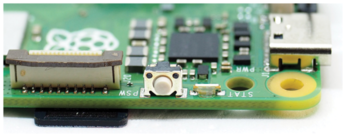Time controlled or remote Raspberry Pi 5 boot
Wake-up Call

© Lead Image © Darek Chramienko, 123RF.com
In addition to enhanced performance, the Raspberry Pi 5 also comes with some new hidden functions, including options for time-controlled and remote start-up and shutdown.
In the past, restarting a shutdown Raspberry Pi was a little archaic: briefly pull out the plug and then plug it back in again. If you wanted to make things easier, you could use a cable with a built-in button or use a HAT, which was especially useful if you wanted a time-controlled reboot.
The Raspberry Pi 5 now finally has a dedicated power button (Figure 1). You can use it to start the Raspberry Pi when it's switched off and also shut it down cleanly before it switches off the power (the operating system will even show a prompt if you're running a desktop system). In this article, I will show you some further useful features for switching the Raspberry Pi 5 on and off.

[...]
Buy this article as PDF
(incl. VAT)
Buy Linux Magazine
Subscribe to our Linux Newsletters
Find Linux and Open Source Jobs
Subscribe to our ADMIN Newsletters
Support Our Work
Linux Magazine content is made possible with support from readers like you. Please consider contributing when you’ve found an article to be beneficial.

News
-
Mozilla Plans to AI-ify Firefox
With a new CEO in control, Mozilla is doubling down on a strategy of trust, all the while leaning into AI.
-
Gnome Says No to AI-Generated Extensions
If you're a developer wanting to create a new Gnome extension, you'd best set aside that AI code generator, because the extension team will have none of that.
-
Parrot OS Switches to KDE Plasma Desktop
Yet another distro is making the move to the KDE Plasma desktop.
-
TUXEDO Announces Gemini 17
TUXEDO Computers has released the fourth generation of its Gemini laptop with plenty of updates.
-
Two New Distros Adopt Enlightenment
MX Moksha and AV Linux 25 join ranks with Bodhi Linux and embrace the Enlightenment desktop.
-
Solus Linux 4.8 Removes Python 2
Solus Linux 4.8 has been released with the latest Linux kernel, updated desktops, and a key removal.
-
Zorin OS 18 Hits over a Million Downloads
If you doubt Linux isn't gaining popularity, you only have to look at Zorin OS's download numbers.
-
TUXEDO Computers Scraps Snapdragon X1E-Based Laptop
Due to issues with a Snapdragon CPU, TUXEDO Computers has cancelled its plans to release a laptop based on this elite hardware.
-
Debian Unleashes Debian Libre Live
Debian Libre Live keeps your machine free of proprietary software.
-
Valve Announces Pending Release of Steam Machine
Shout it to the heavens: Steam Machine, powered by Linux, is set to arrive in 2026.

